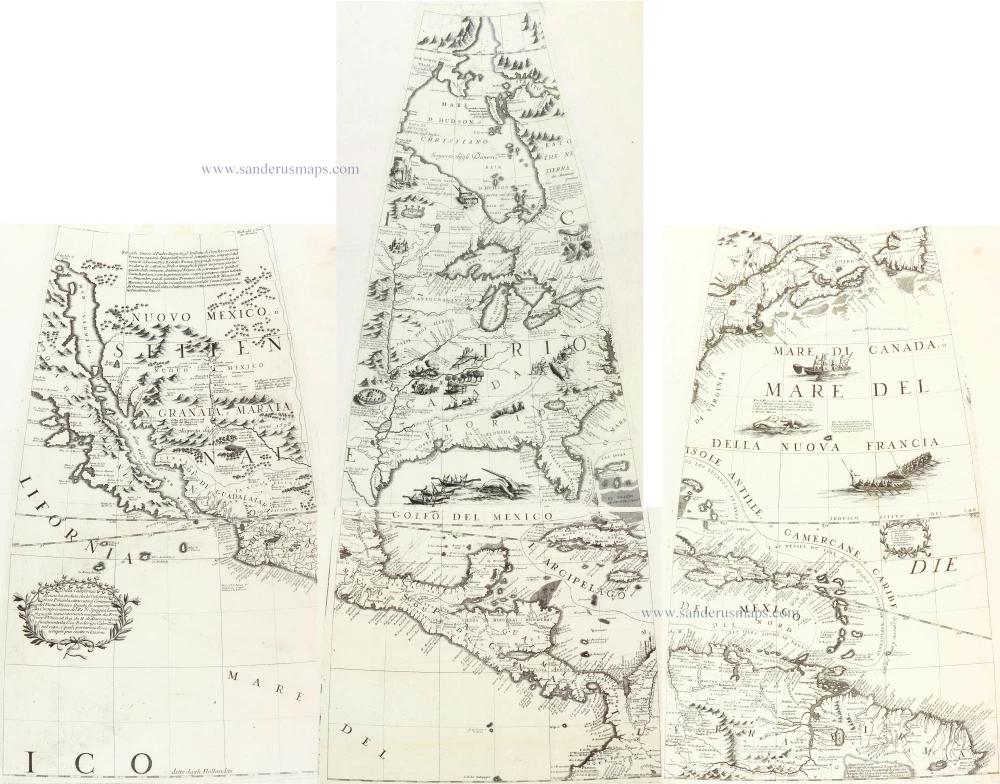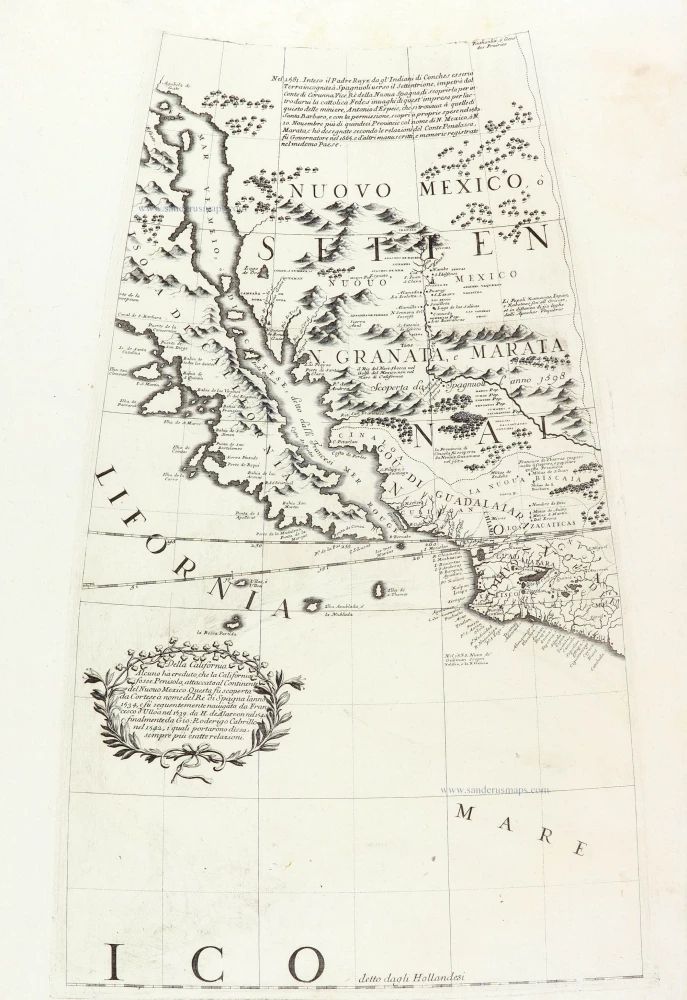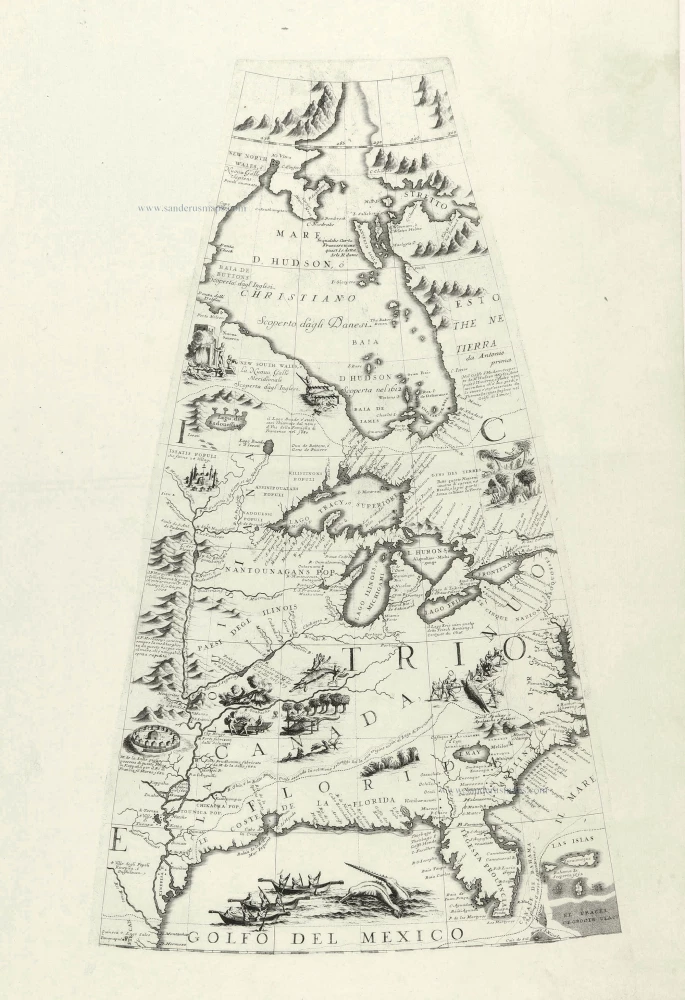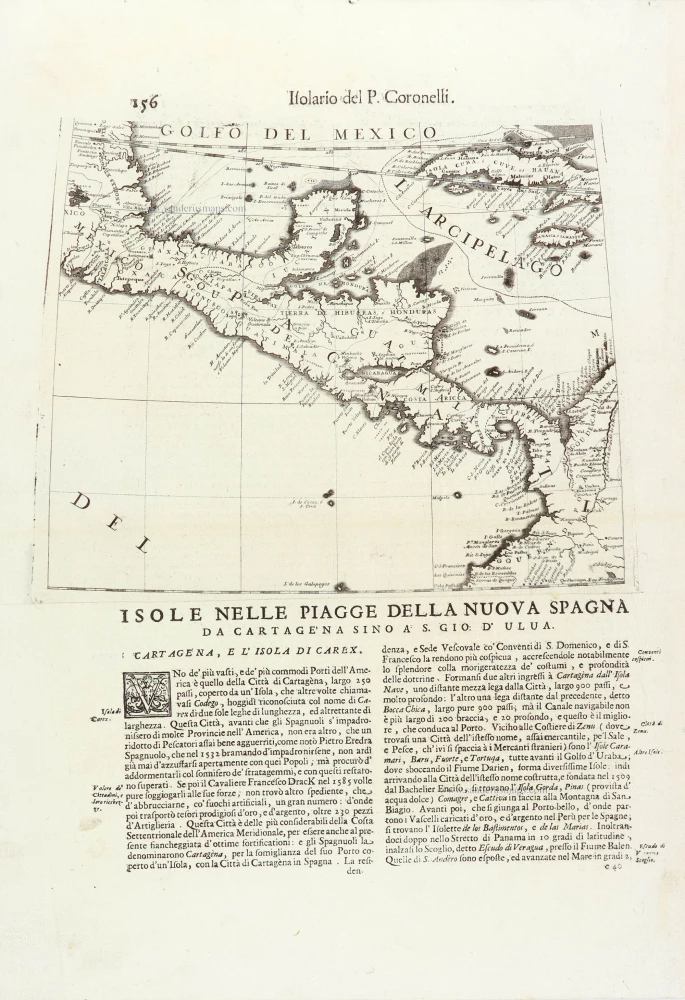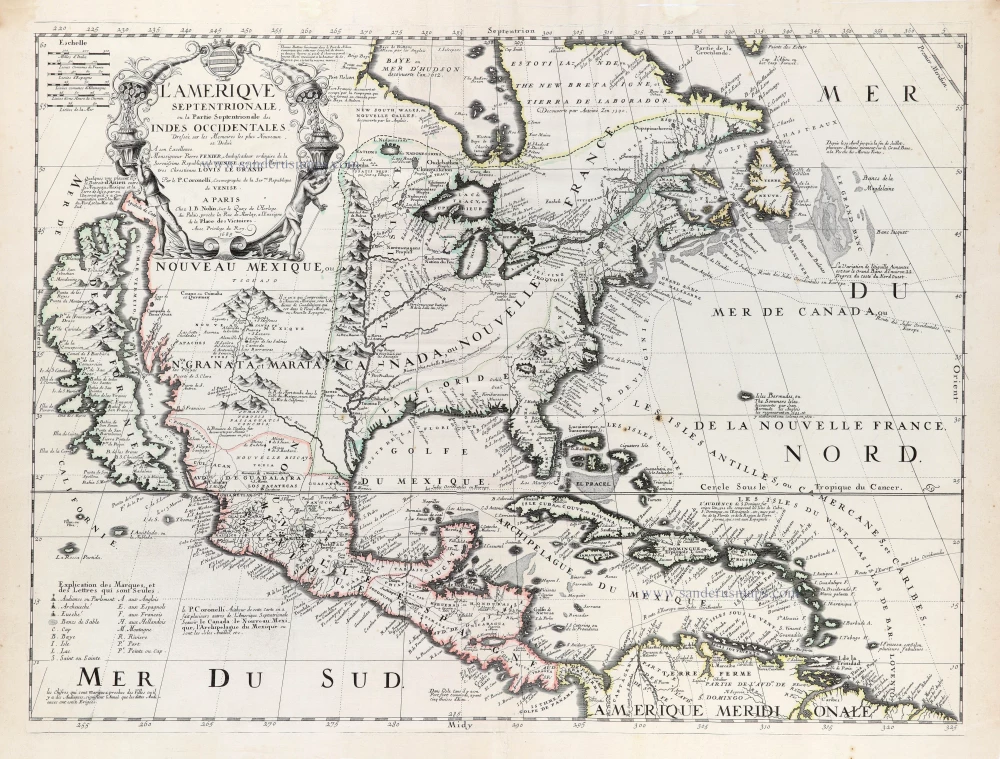Rare. Four gores.
North America by Coronelli Vincenzo 1696
Shirley: "The engraving and design throughout are of the highest standard with neat contrasting lettering and five cartouches of singular grace and elegance. ... The most interesting feature of the gores is the recording of the recent French explorations in North America. The Mississippi is marked, following La Salle's journeys to its mouth in 1681-87, and the boarding territory is boldly marked La Louisiana. Ambitious French aspirations can be read into the spread of the title Canada - Nuova Francia across nearly all the lands east of the Mississippi, apart from a central coastal strip and the territories of Carolina and Florida in the south. Along the conjectural course of the River Ohio is the suggestion that this has its source in Lake Frontenac, i.e. Lake Erie."
Vincenzo Coronelli (1650-1718)
Vincenzo Coronelli was born in Venice on 16 August 1650 and primarily brought up in Ravenna. He returned to Venice in 1665 and joined the convent of the Minor Conventuals. Five years later, he was sent to Rome to study, and by 1673, he was already a doctor of theology.
Having achieved fame by constructing two globes for the Duke of Parma, he was invited to Paris for three years in 1681 and made two enormous examples for Louis XIV. On his return to Venice, he assiduously collected cartographic material and founded the Academy of the Argonauts. In 1685, he was appointed Cosmographer to the Republic of Venice and authorised to publish a large atlas. He became a geography lecturer at the University of Venice and brought out an Atlante Veneto the following year.
In 1696, he visited Germany, Holland and southern England. During intervals in compiling his vast encyclopaedia, he continued with cartographic projects up to 1709. He died in his native Venice on 9 December 1718.
Coronelli became famous for his globes. In addition, he was a renowned encyclopaedist, mapmaker and geographer. Most of his maps and other material are gathered in his Atlante Veneto (13 vols, 1690-1705). The first volume, subtitled Descrizione generale istorica geografica, was his masterpiece, planned as an extension of Blaeu’s atlas.
Other volumes of the atlas which contain maps are Isolario, two parts (1696-8), with detailed maps and plans, mostly of islands; Corso geografico, two parts based on the edition 1694-7; Libro de’ globi (1697); and Lo Specchio del Mare, a reprint of Levanto's Lo Specchio del Mare Mediterraneo of 1664.
The other vital aspects of his mapping are those arising from the Venetian conquest and his travels. His most extensive military compilation was the Teatro della Guerra, in more than 30 volumes.
[No title]
Item Number: 29448 Authenticity Guarantee
Category: Antique maps > America > North America
Four globe gores covering North America and Central America, by Vincenzo Coronelli.
Made for Vincenzo Coronelli's 42-inch terrestrial globe.
California as an island.
[No title]
Date of the first edition: 1688.
Date of this map: 1696.
Copper engraving, printed on paper.
Map size each: 460 x 290mm (18.11 x 11.42 inches).
The fourth gore is 230 x 290mm (9 x 11.42 inches)
Sheet size: 490 x 360mm (19.29 x 14.17 inches).
Verso: Blank.
Condition: Excellent.
Condition Rating: A+.
From: Isolario Descrittione Geografico-Historica, Sacro-Profano, Antico-Moderna, Politica, Naturale e Poetica ... di Tutti l'Isole ... Tomo II dell'Atlante Veneto ... del P.Maestro Vincenzo Coronelli ... A'Spese dell'Autore MDCLXXXXVI. (Shirley (Brit.Lib), T.CORO-13a)
Shirley: "The engraving and design throughout are of the highest standard with neat contrasting lettering and five cartouches of singular grace and elegance. ... The most interesting feature of the gores is the recording of the recent French explorations in North America. The Mississippi is marked, following La Salle's journeys to its mouth in 1681-87, and the boarding territory is boldly marked La Louisiana. Ambitious French aspirations can be read into the spread of the title Canada - Nuova Francia across nearly all the lands east of the Mississippi, apart from a central coastal strip and the territories of Carolina and Florida in the south. Along the conjectural course of the River Ohio is the suggestion that this has its source in Lake Frontenac, i.e. Lake Erie."
Vincenzo Coronelli (1650-1718)
Vincenzo Coronelli was born in Venice on 16 August 1650 and primarily brought up in Ravenna. He returned to Venice in 1665 and joined the convent of the Minor Conventuals. Five years later, he was sent to Rome to study, and by 1673, he was already a doctor of theology.
Having achieved fame by constructing two globes for the Duke of Parma, he was invited to Paris for three years in 1681 and made two enormous examples for Louis XIV. On his return to Venice, he assiduously collected cartographic material and founded the Academy of the Argonauts. In 1685, he was appointed Cosmographer to the Republic of Venice and authorised to publish a large atlas. He became a geography lecturer at the University of Venice and brought out an Atlante Veneto the following year.
In 1696, he visited Germany, Holland and southern England. During intervals in compiling his vast encyclopaedia, he continued with cartographic projects up to 1709. He died in his native Venice on 9 December 1718.
Coronelli became famous for his globes. In addition, he was a renowned encyclopaedist, mapmaker and geographer. Most of his maps and other material are gathered in his Atlante Veneto (13 vols, 1690-1705). The first volume, subtitled Descrizione generale istorica geografica, was his masterpiece, planned as an extension of Blaeu’s atlas.
Other volumes of the atlas which contain maps are Isolario, two parts (1696-8), with detailed maps and plans, mostly of islands; Corso geografico, two parts based on the edition 1694-7; Libro de’ globi (1697); and Lo Specchio del Mare, a reprint of Levanto's Lo Specchio del Mare Mediterraneo of 1664.
The other vital aspects of his mapping are those arising from the Venetian conquest and his travels. His most extensive military compilation was the Teatro della Guerra, in more than 30 volumes.

